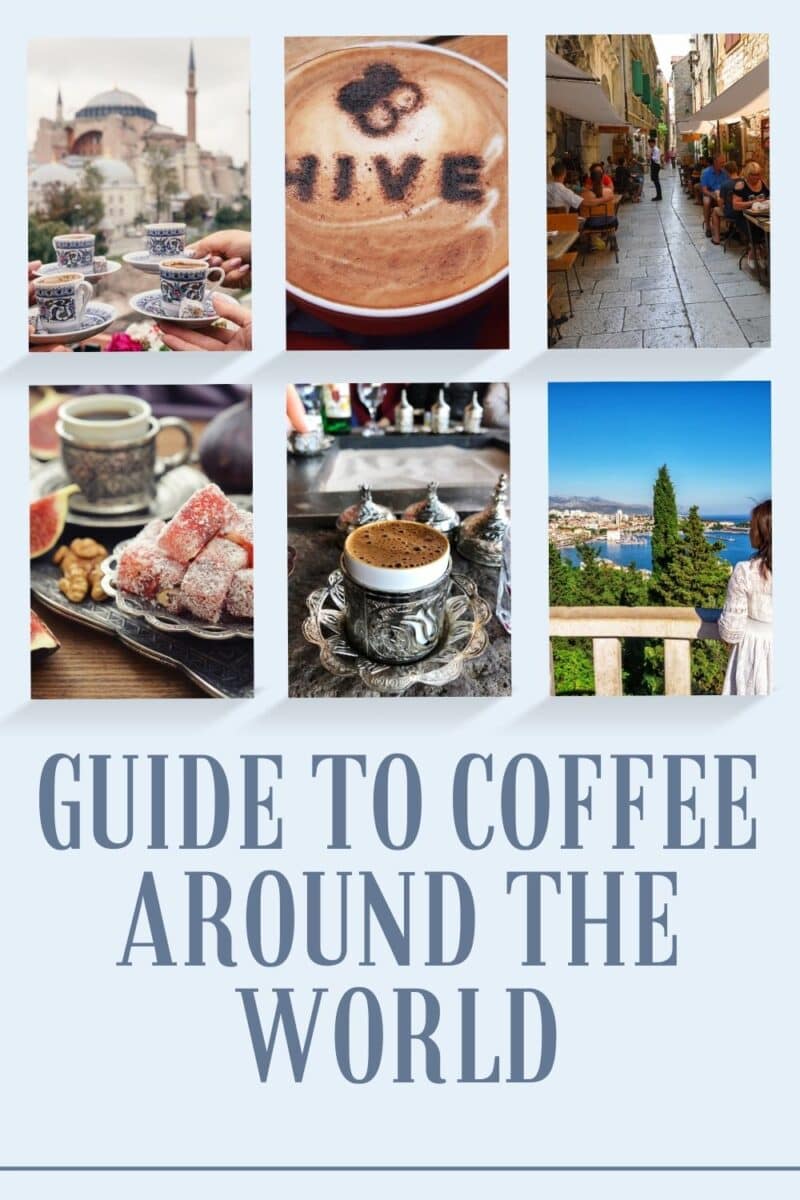The ultimate guide to coffee around the world – 33 coffee traditions & rituals
Taking part in a coffee ritual or simply enjoying a coffee and people watching from a cafe around the world gives a traveller a window into the culture of that community. Coffee traditions around the world varies as much as the people who brew it.
Coffee’s influence on culture is written in our communities and has a vast history of colonialism and slavery which should not be overlooked. Coffee culture around the world takes on many roles and has had a great impact on history and the growth of trade and communities.

I would rather suffer with coffee than be senseless. Napoleon Bonaparte
- The ultimate guide to coffee around the world – 33 coffee traditions & rituals
- A brief history of Coffee Around the World
- Coffee Culture Trivia
- 33 Coffee Rituals around the World
- Kopi Luwak – Bali
- Abatanado Coffee – Portugal
- Coffee in Croatia – Kava
- Geisha Coffee – Panama
- Cafezinho – Brazil
- Cappuccino – Italy
- Cortado – Argentina
- Cuban Coffee – Cuba
- Coconut Coffee – Vietnam
- Greca Coffee – Dominican Republic
- Espresso Marocain – Morocco
- Flat White – Australia
- Tanzanian Coffee – Tanzania
- Bosanska kafa – Bosnia and Herzegovina
- Café Lao – Laos
- Viennese Coffee – Austria
- Fika – Sweden
- Kumbakonam Degree – India
- Gahwa – Oman
- Luwak – Indonesia
- Kafu – Bosnia
- Bunna – Ethiopia
- Ca Phe Sua Da – Vietnam
- Espresso – Rome
- Kahvesi – Turkey
- Egg Coffee – Vietnam
- Boon – Eritrea
- Kaapi – South India
- Frappé – Greece
- Cafe de la Olla – Mexico
- Kahawa Chungu – Kenya
- Tims Double Double – Canada
- Boon – Eritrea
- Drip Coffee – USA
Xyuandbeyond is reader-supported. When you buy through links on our site, we may earn an affiliate commission. You can read my privacy policy here.
Coffee Flavours
One bean has many flavours, strengths and ways to consume it. Coffee around the world varies a great deal, here in North America we love adding flavours and alternative milk to our quad long shot grande in a venti cup half calf double cupped no sleeve salted caramel mocha latte with 2 pumps of vanilla substitute 2 pumps of white chocolate mocha for mocha and substitute 2 pumps of hazelnut for toffee nut half whole milk and half breve with no whipped cream extra hot extra foam extra caramel drizzle extra salt add a scoop of vanilla bean powder with light ice well stirred.

In many countries in Europe and the Middle East, coffee is typically brewed very strong such as espresso that comes in a tiny cup without sugar or milk. In Scandinavian countries, they add a whole raw egg to a large pot of coffee. This is believed to clarify the coffee giving it a cleaner taste.
In Thailand, the favourite brew is iced coffee or “Oliang,” to which condensed milk and spices can be added. In Vietnam, they add an egg yolk to make the coffee richer.
A brief history of Coffee Around the World
First discovered in Ethiopia legend has it that local goat herders watched their goats frolic after ingesting the coffee cherry. Initially coffee was not a beverage but food that was crushed and used as a form of travelling food. From here the use of coffee spread to the Middle East, it is believed by slaves brought into Arabia and as thousands of pilgrims converged on Mecca they were treated to Qahwah. Later this becomes known as Kahveh in Turkish and koffie in Dutch.
What historians do know is that the first historical records about the cultivation and preparation of coffee come from the Sufi monasteries of Yemen in the middle of the 15th century.
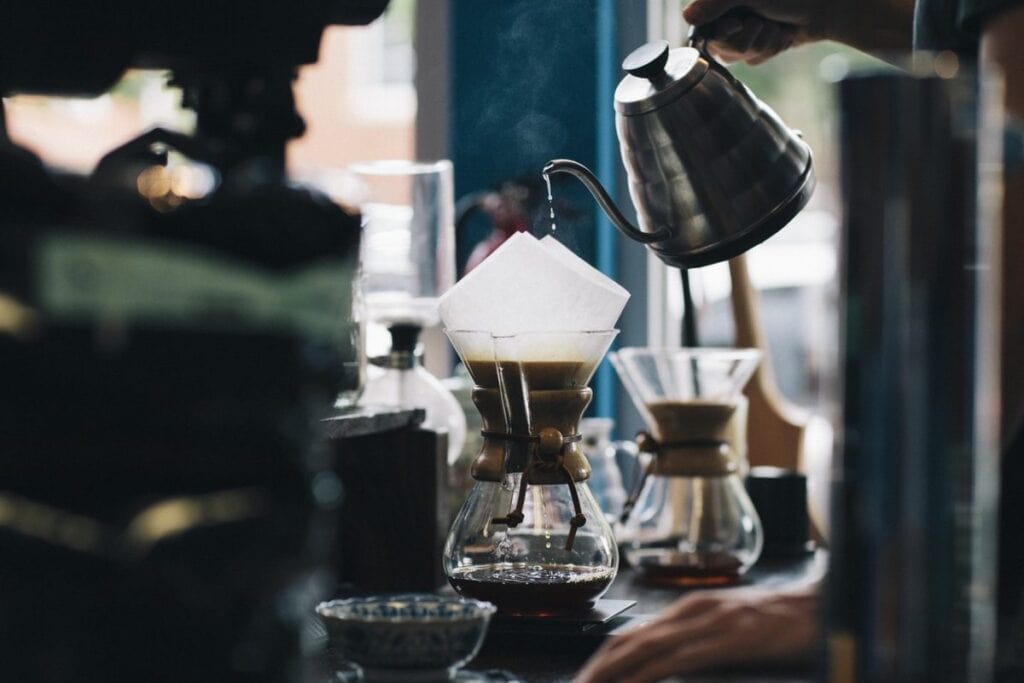
Arab leaders were determined to maintain a monopoly on coffee and banned the export of beans. However, in the 1600s the Dutch found a way around the restrictions by importing coffee plants and the rest of the world was introduced to coffee.
From these plants, the coffee house culture was born and they became a centre for political discourse, community rebellion (think Le Miz and the French Revolution), community development and a home for artists of all kinds, painters, poets and writers.
Coffee Culture Trivia
*Coffee houses opened in Oxford in 1652 and in fact Lloyd’s of London was Edward Lloyd’s Coffee House before becoming a worldwide insurance company.
*In Paris the first coffee house appeared in 1672, and Paris’s most famous shop called Café Procope was launched in 1686 and remains open to today. This Café was a meeting place for scholars and artists during the Enlightenment and more than likely the birthplace of the encyclopedia.
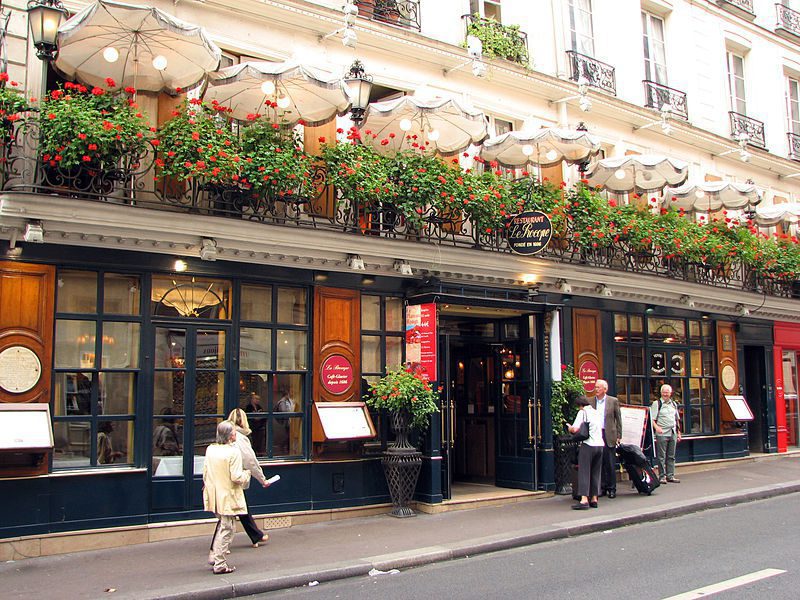
* Finland is the only country in the world wherein some Union agreements it states that there should be 2 coffee breaks a day.
*The average adult Finn goes through 27.5 pounds of coffee each year, compared to 11 pounds per American.
*Coffee houses in England started the custom of tipping by putting money in a tin labelled “to insure prompt service”.
*Jonathan’s Coffee House in London was where the city’s stockbrokers met and it became the London Stock Exchange.
*Bach’s Coffee Kantata, composed in 1732 was composed as an ode to coffee. The cantata includes the aria “Ah! How sweet coffee tastes! Lovelier than a thousand kisses, sweeter far than muscatel wine! I must have coffee…”
*Brazil grows the most coffee in the world.
*The world’s most expensive coffees include Black Ivory coffee which costs €99 euros per 1.23 ounces. The beans are sustainably sourced from the poop of elephants in Thailand. Also Panamanian Geisha coffee, Kopi Lewak of course, Ospina Dynasty Gran Cafe Premier Grand Cru from Colombia and Hacienda El Roble also from Colombia.
33 Coffee Rituals around the World
Kopi Luwak – Bali
Whenever you are in Bali, you will probably visit a tea plantation but visiting a coffee plantation such as Satria Agrowisala is also a must.
We tried one of the world’s most expensive coffees at the plantation. The coffee is made from faeces from the Luwak or civet cat. These cats live near the plantation because they love to eat coffee berries. After digesting the seeds are recovered washed, dried and roasted. The coffee that is made from these beans has a unique, sweet taste. You don’t have to add milk or sugar.
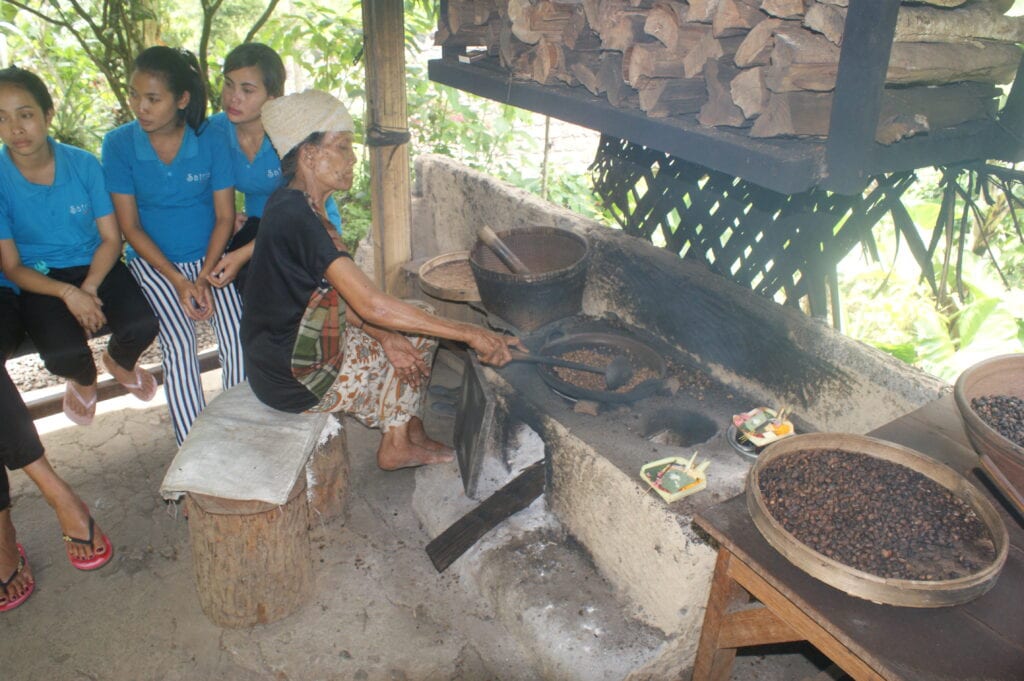
Most plantations keep a few civet cats in captivity. The coffee that is made costs around 200 euros per kilo. If you want to drink coffee from the faeces of the wild civet cat, you have to pay at least 5000 euros per kilo. Contributed by Wendy of World Wide Wendy.
Abatanado Coffee – Portugal
In Portugal, it is common to order ‘um abatanado’ to have alongside the Portuguese national pastry, a pastel de nata, the national custard-like tart. An Abatanado is the equivalent of an Americano and is a large coffee compared to the bica (espresso).
The Portuguese are famed for their coffee culture and the coffee is good. With close ties to South America, it is easy to understand why coffee features in Portuguese culture. An Abatanado is served in a short mug, usually with one or two sachets of sugar. It is typically strong, black, filtered coffee and if you are looking for milk to add to it, you need to request ‘um pouco de leite’ as milk is not added to coffee by the Portuguese.
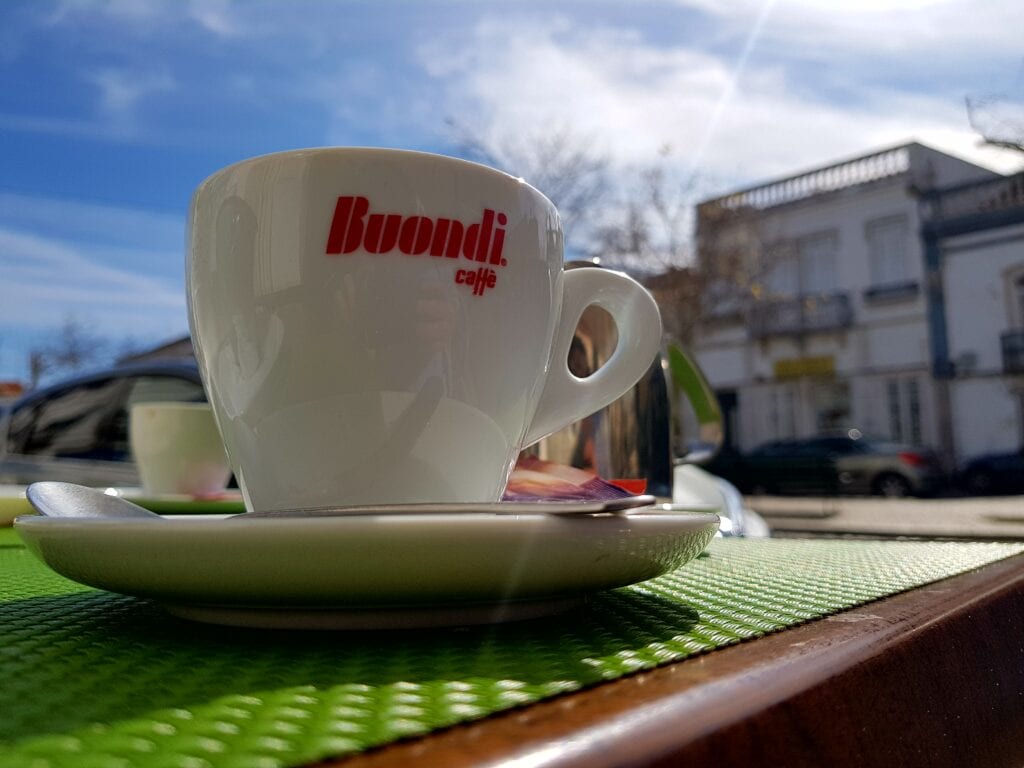
For those who prefer espresso, order a bica and enjoy your café with a pastel de nata. Make sure to add some cinnamon on top for a truly Portuguese experience. Contributed by Cath – Moving to Portugal
Coffee in Croatia – Kava
Croatians have been drinking coffee since the 1700’s. The coffee culture in Croatia is a fusion of Turkish, Austro-Hungarian, and Italian influences. Among these, Turkish coffee stands out as a prime example of how Croatia’s historical ties with Turkey have shaped its cultural landscape. Even today, the Turkish method of brewing coffee remains the favored tradition in Croatian households, particularly when hosting guests.
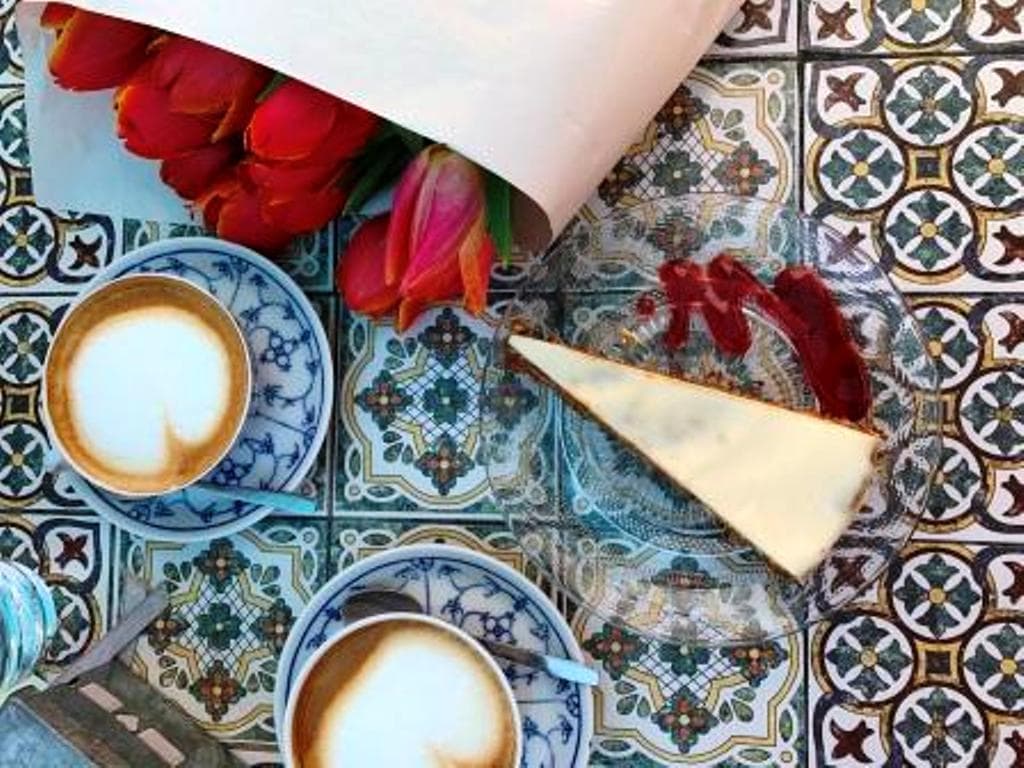
Geisha Coffee – Panama
In Boquete, a small town on the slopes of Volcán Barú in Panama, farmers grow some of the best and most expensive coffee in the world.
The unique combination of microclimates that forms around the volcano and the plentiful water from the cloud forest give Geisha coffee its distinct and complex flavour profile. The Geisha plant is difficult to grow and yields lower quantities than other crops, that is why it fetches such a high price on the market and it’s only sold in speciality coffee shops.

Each farm produces its own variety; some have fruity notes of Jasmine and citrus, and others taste of caramel and chocolate. During our tasting tour, we were served a cup of Geisha that is smooth and light on the palate, and it tastes more like delicious tea than coffee.

Hot water is poured on the coffee grounds directly into the cup. It is best served without sugar or milk, to enjoy its delicate tea-like flavour and appreciate all the different aromas. Contributed by Jules of Julestrails.
Cafezinho – Brazil
Whether you are planning a trip to Brazil, or are just curious about the Brazilian culture, the coffee ritual is a big part of Brazilian congeniality. Everywhere you go, in any meeting, chat, soon the talk will be briefly interrupted by a question: “Would you like a cup of coffee?” From then on, the reception will get sweeter and the chat, more pleasurable.

Espresso is common in Brazil, just like in many other countries. However, one coffee is still made in an old-fashioned way, from the days when the grain was the main export product of the Brazilian economy, in the late XIX century. At barons’ farms, coffee used to be ground on the spot, the powder was placed in a cloth filter on the teapot and, hot water was poured onto it. A ritual was repeated several and several times a day, so one could always drink fresh coffee.
This ritual of straining the coffee still exists in bakeries and coffee shops in Brazilian cities. This cafezinho (how it is called in Brazil), starts with the smell, which involves and arouses desire before you even taste it. Contributed by Paula of Paula Pins the Planet.
Cappuccino – Italy
In Italy, for breakfast, I had a choice of a coffee drink to go along with my cornetto. My drink of choice was a cappuccino, a hot beverage, espresso-based, topped with a layer of frothed milk.
The drink is made with 1 shot of espresso and foamed milk. In some places, they also offer cremina (or crema), which is just milk foam whipped with sugar. Because, typically, cappuccino is served without sugar (there are sugar packets on the tables and at the bar, plus it’s served with a sugary treat).
The drink is named after the Cappuccini (as it resembles the monks’ hood colour).
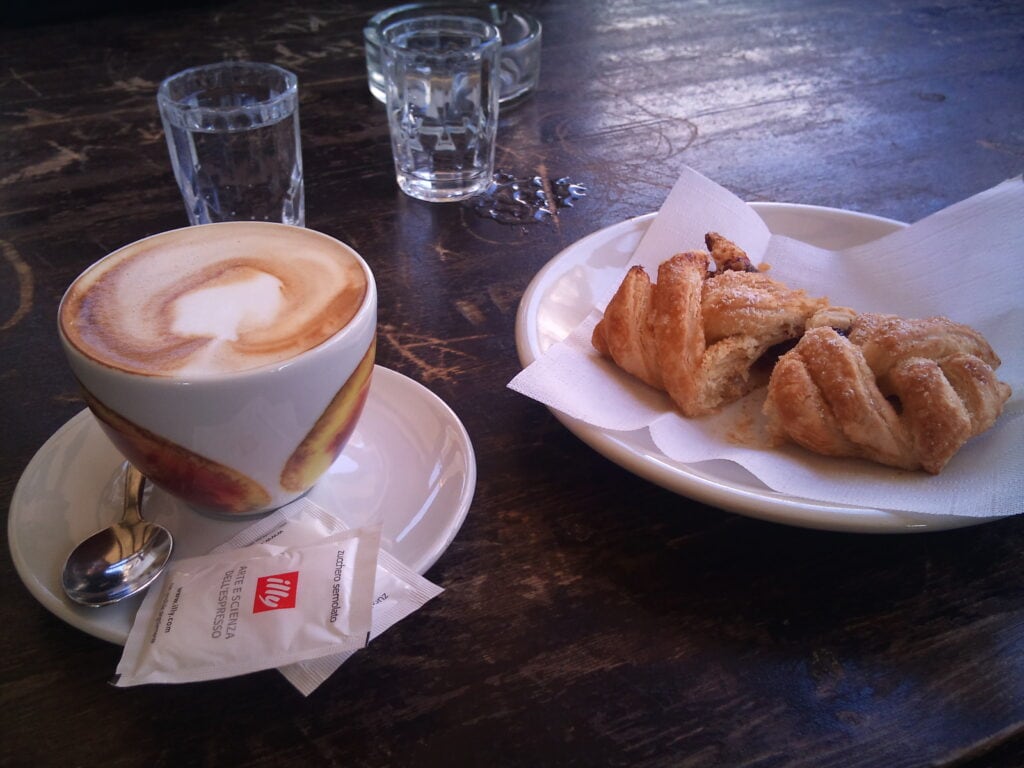
Cappuccino is always a breakfast drink. The lactose and the fat that includes will keep you going for a good part of the day and the milk upsets digestion later in the day.
Since it’s more filling than a simple espresso, you should never order a cappuccino after a meal. Especially at local cafes, where you won’t see many tourists, don’t order a cappuccino in the afternoon (unless you want some very funny looks). Contributed by Cris of LooknWallk.
Cortado – Argentina
Buenos Aires, Argentina is known for its café culture, with a café on every corner making sharing a coffee a central part of social interaction and the simple pleasure of living in Buenos Aires. With its coffee culture here largely inherited from Italian immigrants, coffee is Buenos Aires is most often taken as traditional espresso when ordered as a “café” or as a “cortado,” as an espresso cut with a bit of milk.
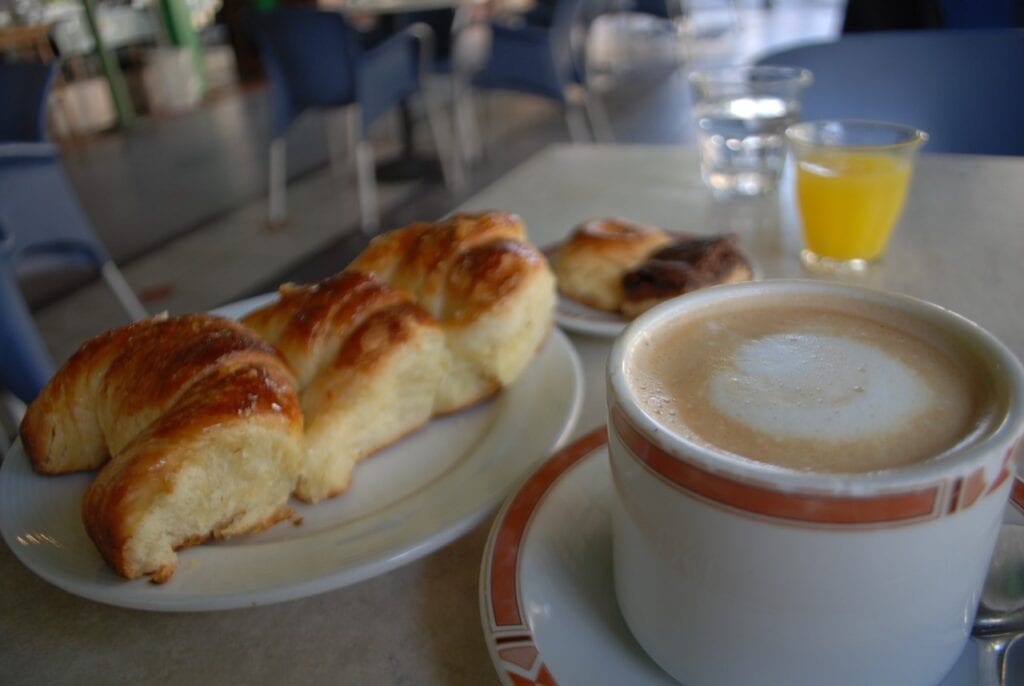
What Buenos Aires may lack in terms of the uniqueness of coffee itself, it makes up for in coffee presentation and service. Even the simplest coffee order comes served with seltzer water and chocolate. Coffee is commonly accompanied by “medialunas,” sweet crescent rolls with a light sugar glaze, or other “facturas” an array of sweet pastries often filled with dulce de leche or other sweet cream or fillings. Contributed by Carley Rojas Avila of Home to Havana.
Cuban Coffee – Cuba
Cuban coffee is universally known for being strong and sweet. While there are plenty of cafes in Havana and Miami with their own inventive takes on Cuban coffee, the true Cuban coffee is prepared with espresso-like Café Pilón or Café La Llave and prepared in a Greca pot. To create the ideal frothy top for the coffee, a small amount of the first coffee to simmer up into the Greca is mixed vigorously with two tablespoons of sugar until the sugar is melted.
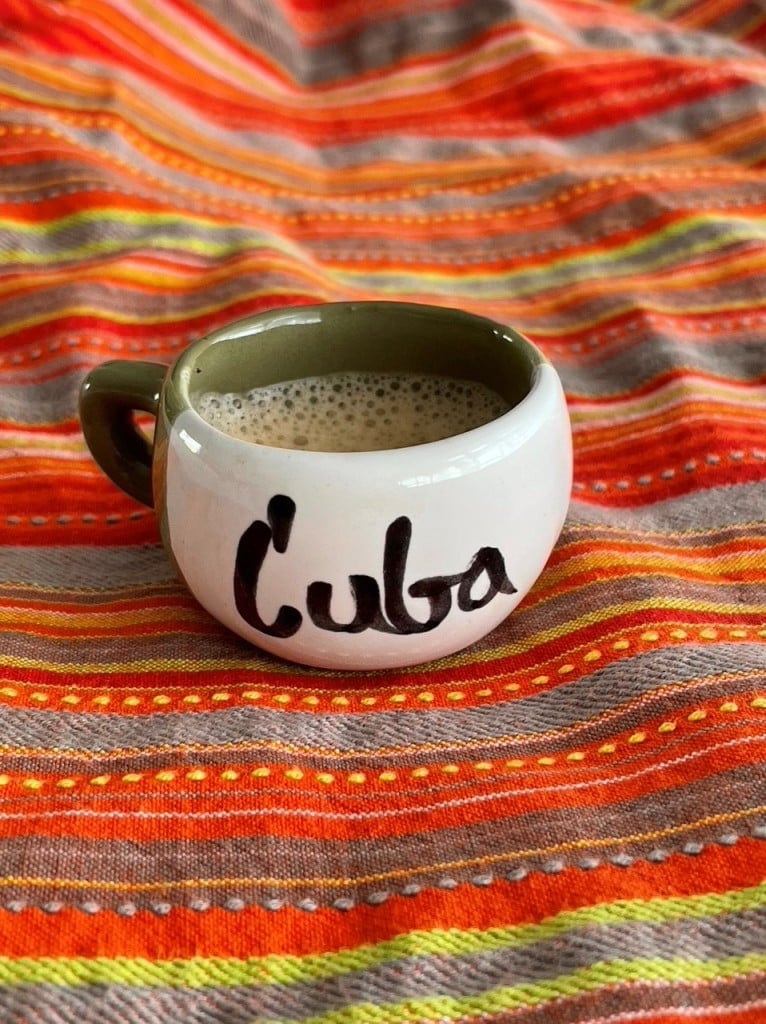
Once the rest of the coffee simmers, it is added to the melted sugar mixture, leaving the perfectly frothy top. Served in a demitasse cup or espresso mug, all that coffee and sugar packs quite a punch. Carley Rojas Avila of Home to Havana.
Coconut Coffee – Vietnam
Mix the intense Vietnamese coffee with strong-flavoured coconut milk and I guarantee you will immediately fall in love. That was my first impression as we arrived in the centre part of Vietnam, on our second trip to the Asian country.
I had previously developed a strong relationship with the cà phê đá, but during our trip to Da Nang, I discovered the updated and improved version: iced coconut coffee.
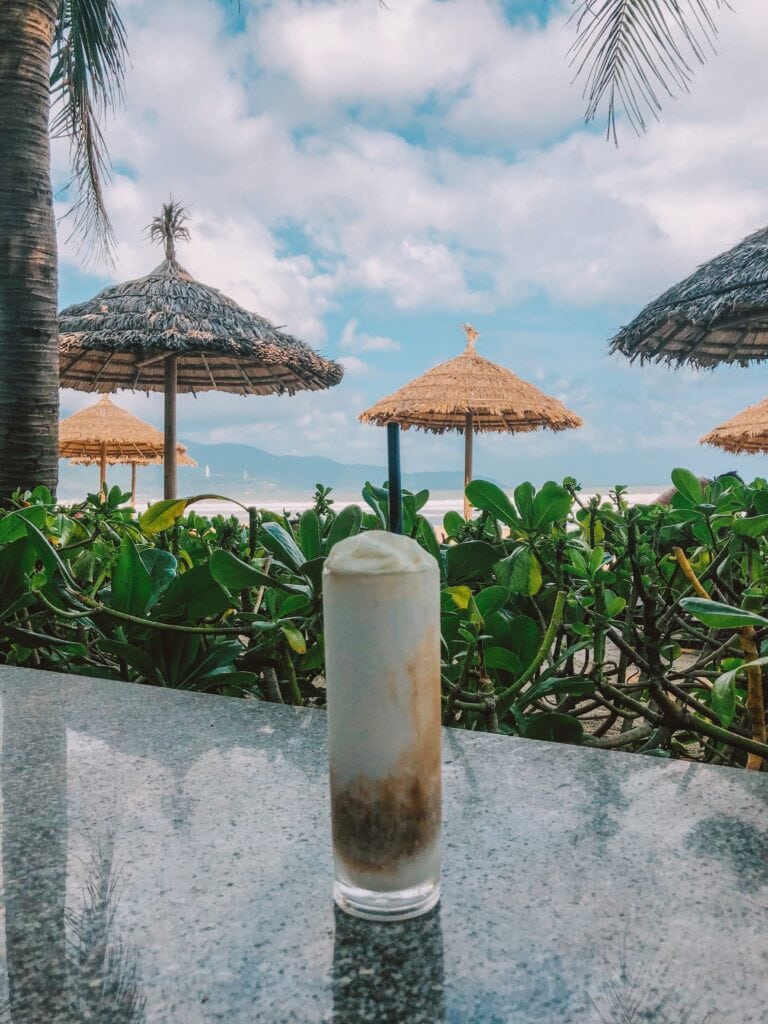
Strong Vietnamese drip coffee is mixed with crushed iced and heavy delicious coconut cream, resulting in a drink so delicious I couldn’t stop ordering it everywhere I went. The liqueur is not as sweet as some might expect, and it is just strong enough. Contributed by Ingrid of Ingrid Zen Moments.
Greca Coffee – Dominican Republic
The “Greca” is a typical Dominican household item, which is indispensable for every Dominican family. It is a small jar made of steel, with a water reservoir below, an area to place the coffee powder in the middle and an empty space to catch the coffee on top. The water gets heated on the stove, evaporates, reacts with the coffee powder and gets pushed to the top, where the liquid coffee is collected.
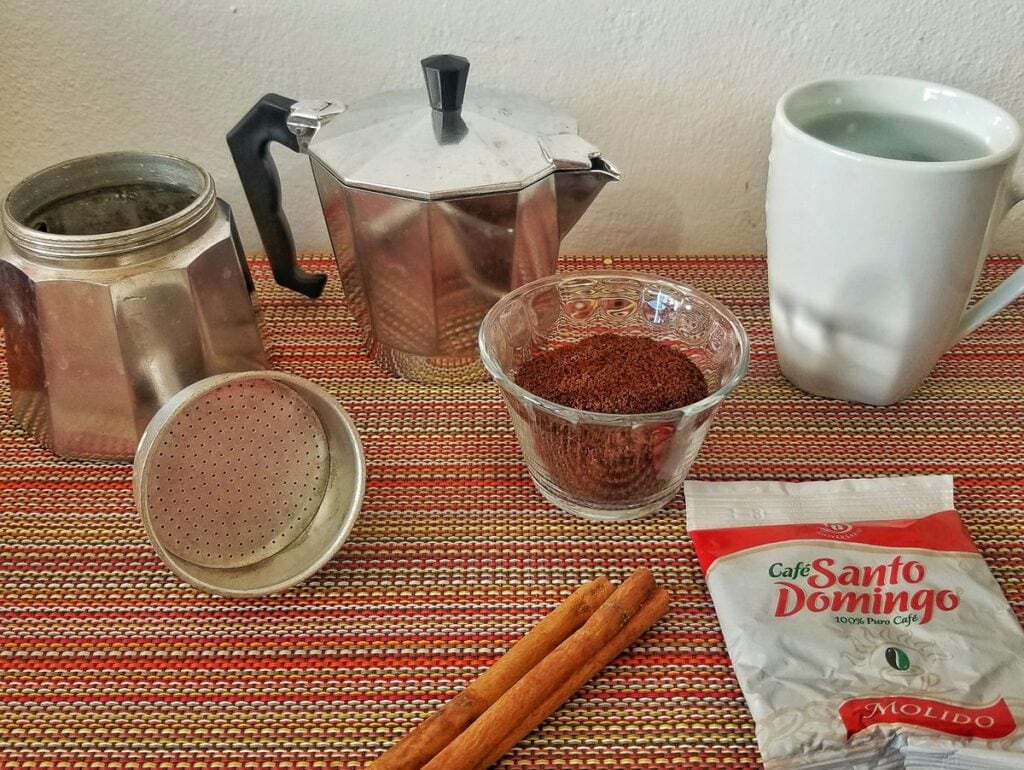
Preparing coffee in a Greca is a very traditional form of the process, but one that is omnipresent in every Dominican household, it doesn’t matter if in the capital Santo Domingo, in the famous holiday destination Punta Cana or in small villages in the countryside.
Most families even prefer this method over modern coffee machines, as the aroma and smell of Dominican coffee come into their own much better. While there are a lot of local brands in the country, the most famous Dominican coffee is “Santo Domingo” which is available nationwide and also via Amazon. Contributed by Chris of Punta Cana Travel Blog.
Espresso Marocain – Morocco
In Marrakech, I was served an espresso Moroccan spiced coffee which is called espresso marocain spiced noisette (with milk) and usually costs 20 dhs. It is served from a golden-plated coffee pot without handles. It can be served with sugar and milk or plain.
The espresso Moroccan spiced coffee is part of the new Moroccan coffee culture, which mingles espresso beans with a blend of mixed spices. This coffee may include freshly ground cinnamon, black pepper, cardamom, cloves, salt, ground ginger, and nutmeg.
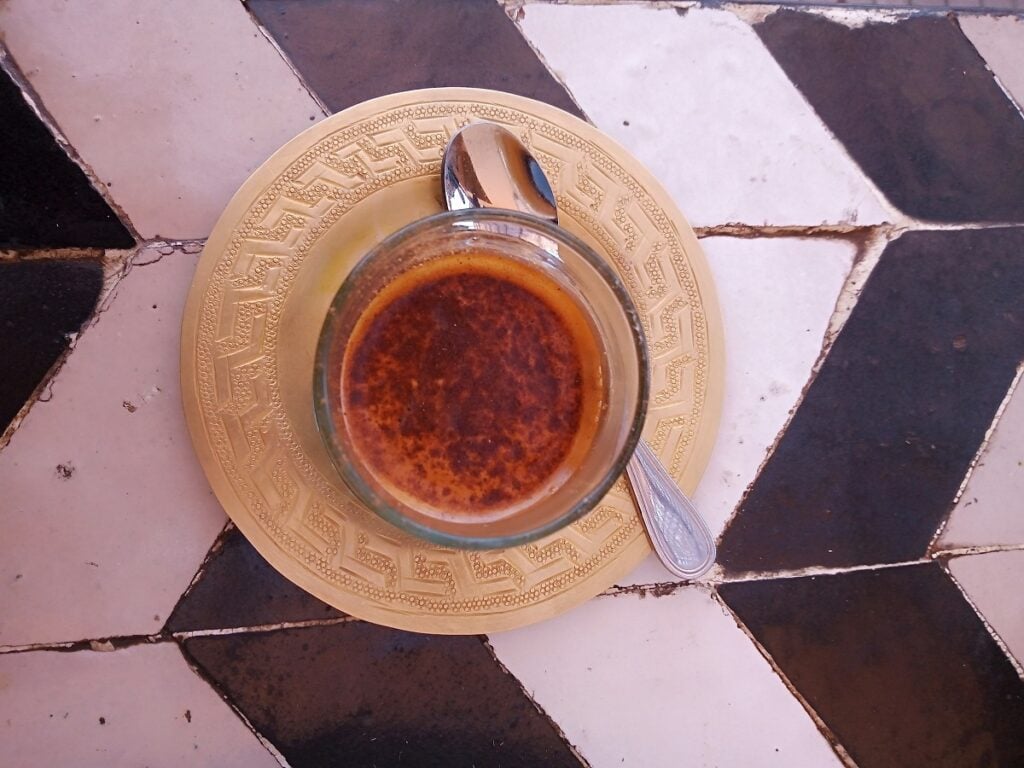
While mint tea and freshly squeezed orange juice feature the most famous national drinks of Morocco, Moroccan coffee does not fall behind. What makes Moroccan spiced coffee smell so good is the unique aroma of dark coffee flavoured with warm spices.
One of the best things to do in Marrakech is to visit a Moroccan house to experience authentic Moroccan coffee. To make Moroccan coffee at home, add 1/4 teaspoon of your chosen spice, mix it with the coffee grounds and get to brewing. Contributed by Evelina of Evbeing.
Flat White – Australia
The morning coffee ritual is a serious business in Australia. Picking up a coffee from our favourite coffee shops is an essential part of the morning commute for most Australians. Over 1.3 million coffees are brewed and sold each day across Australia. And, of course, Australia’s obsession with coffee is not limited to the white-collar crowd in the cities. We expect a good quality cup of coffee from a local coffee shop even when we head on a hike in the mountains.
The only coffee you will find in Australia is the barista-brewed espresso-style beverage, with Australia’s own flat white being one of the most popular choices. A flat white is an espresso-based coffee made with two shots of espresso and the velvety microfoam which is a mix of froth and liquid milk. A flat white is all about how the milk is steamed and poured. The secret to a proper flat white is to preserve the crema – the sweet honey-brown layer of caramelised coffee that floats to the top of the espresso shot.

Unlike a latte where the crema is diluted with milk or a cappuccino where it’s drowned under the weight of froth, in a flat white, the creamer is enriched by a thin and skilfully poured a velvety layer of microfoam. As a result, you get a more flavoursome drink with a stronger taste of coffee than milk. The perfect brew to start your day. Contributed by Margarita Steinhardt / The Wildlife Diaries.
Tanzanian Coffee – Tanzania
In Tanzania, I experienced the traditional way of brewing coffee, during a coffee tour from Moshi. The small coffee farm on the slope of Mountain Kilimanjaro was almost hidden by the tall banana trees growing alongside it and protecting it from the direct sunlight.
The owner first showed me around the farm, then he invited me to sit on a log bench and together with his son, demonstrated how to make coffee without any modern equipment. Firstly, he crushed the dried beans in a giant mortar, with an even bigger pestle. During this time, they sang songs of encouragement: “Twanga Twanga Tunywe Kahawa” (Grinding, grinding, drinking coffee).
Soon the beans separated from their husks. The farmer put them on the flat bamboo basket to shake away the impurities, then he dropped them in an iron bowl, over an open fire, to roast. As soon as the beans changed their colour to dark brown, they were taken out and put back into the mortar and crushed into a fine powder.
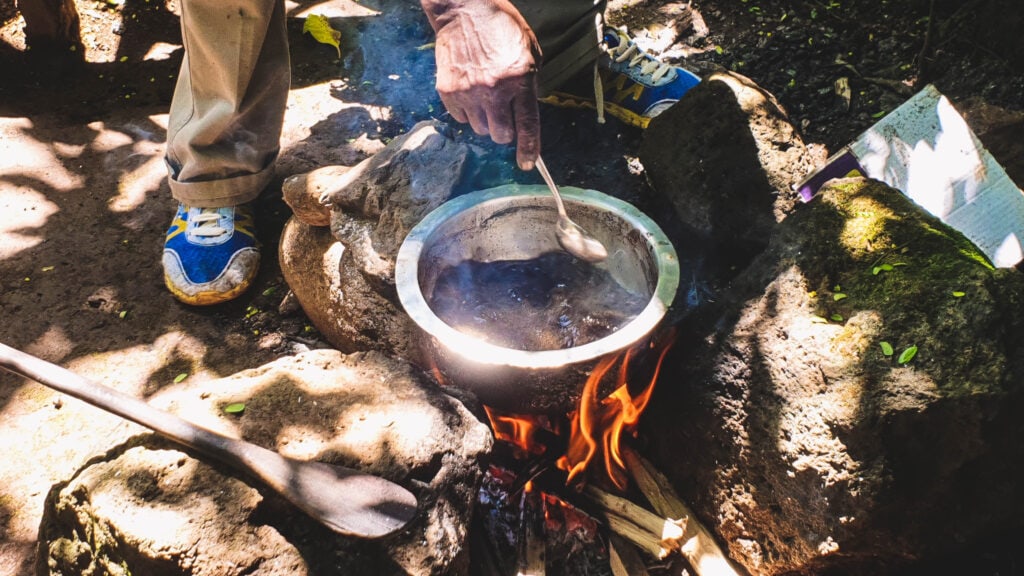
To make the coffee, the farmer mixed the ground beans with boiling water, in a pot over a wooden fire. When it was ready, he poured it into cups through a sieve, just in case any impurities ended up in the pot. The coffee had an intense taste, with a slightly acidic berry aftertaste. Contributed by Joanna from Theworldinmypocket.
Bosanska kafa – Bosnia and Herzegovina
Coffee is the beverage of choice in Bosnia and Herzegovina, especially in Baščaršija, Sarajevo’s Old Town, where old-timey cafes are a dime a dozen. Bosnia’s coffee traditions are rooted in the nation’s Ottoman heritage – but as any local is quick to point out, Bosnian coffee is quite distinct from Turkish coffee but very similar to Croatian coffee.
Coffee is prepared in a džezva, a small copper pot with a long neck and a long handle. Whereas Turkish custom dictates that coffee is added at the beginning, in BiH, the finely ground beans are only added once the water comes to a boil. When a thick foam forms on top, it’s ready.

The coffee is served in the same džezva, arranged on a hand-beaten copper tray along with a small ceramic cup of hot water, sugar cubes, and Lokum – jelly cubes coated in powdered sugar – and a tall glass of cold water on the side.
There’s an art to drinking Bosnian coffee as well. First, you add the hot water from the small cup into the džezva, then transfer a spoonful of foam into the cup before pouring the black coffee in. Before you take a sip, grab a sugar cube and dip it into the coffee then touch it to your tongue – the sweet hit balances out the strong black brew. Contributed By Emily from Wander-Lush.
Bosnian Food – 33 delicious dishes you must try
Café Lao – Laos
Whilst I love seeking out new coffee spots in Vientiane, I return to time and again to the small family-run street stalls for a traditional Lao coffee. Laos produces incredible coffee; most of which is grown in the high altitudes of the Bolaven Plateau in the country’s south.
Lao-style coffee (café Lao) is pretty simple – a strong, hot black coffee served over lashings of condensed milk and powdered creamer. Thick, rich and almost chocolatey, Lao coffee is brewed in a cloth filter “sock” where it is “pulled” (poured) from a height to aerate the coffee and bring it to the right temperature. The coffee beans are usually brewed whole over an open coal fire, which also adds to its distinct flavour.
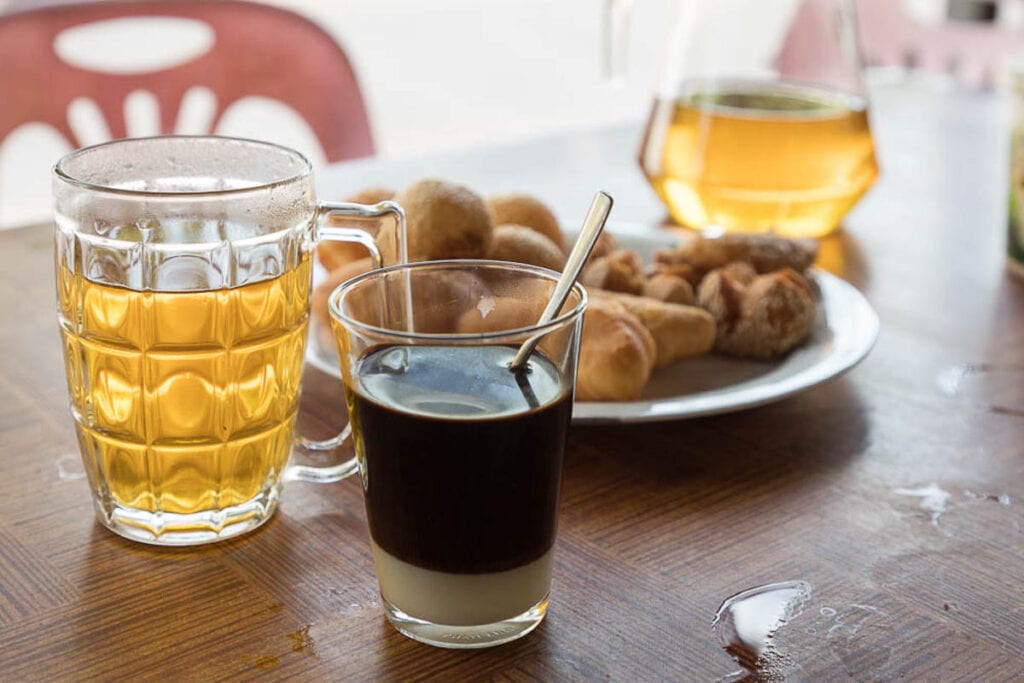
Lao coffee is served hot, in small glasses, over condensed milk and a teaspoon of powdered creamer, and usually accompanied by a Lao-style fried doughnut. Whilst the coffee looks a little muddy in appearance, there is no sediment; rather a rich, dense, intense coffee, perfect for that early morning pick-me-up.
To find a Lao coffee stall, simply look for the red-and-white cans of condensed milk piled artfully in large pyramids at roadside stalls. Contributed by Marie of A Life Without Borders.
Viennese Coffee – Austria
The Viennese Coffee House Culture is listed as a UNESCO Intangible Cultural Heritage in Austria, and many of Vienna’s coffee houses are considered important cultural establishments since they were a gathering place for writers, poets, artists, politicians, and others.
By ordering a single cup of coffee, you have permission to spend as much time as you want in the coffee house and enjoy the regal and elegant atmosphere. That’s why it is said that it’s “where time and space are consumed, but only the coffee is found on the bill.”

In Vienna, the menu might confuse you because coffee has its own names like Melange (espresso with steamed milk, topped with a little foam), Kleiner Schwarzer (a single espresso), or Verlängerter (an espresso with extra hot water), but at least you’ll recognize the cappuccino. Contributed by Or from My Path in the World
Fika – Sweden
“Sweden must have one of the most well-known coffee rituals around the world. It’s called Fika. Fika is a concept, or maybe even a state of mind. You have to visit Sweden to see it with your own eyes and experience it for yourself because Fika is not something you can do at your own desk. Fika is a coffee ritual that is essential every single day.
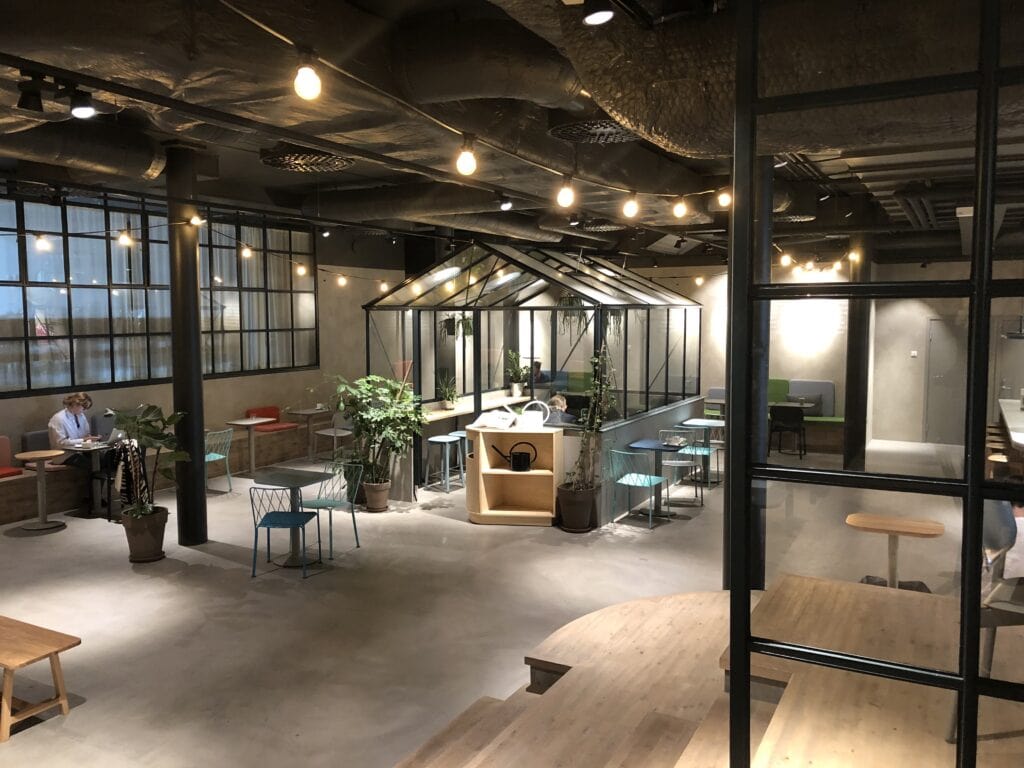
To do it properly, you need to make time for your friends or work colleagues to share a cup of coffee and a little something to eat. Enter any coffee shop in Sweden and you will see a few sweet delights waiting for you to purchase and indulge in alongside your coffee.
In Sweden, Fika is considered a crucial part of the day. We know it’s essential to make time to stop and socialise. Relax, take a break and spark a conversation. It refreshes the brain and strengthens relationships.” Contributed by Cory of Yuzu Bakes.
Kumbakonam Degree – India
India’s love for caffeine can be majorly segregated into 2 – Northern parts of India prefer Tea (called Chai in local languages) while southern parts of India prefer Coffee (called Kaapi in local languages). One of the most popular south Indian coffee is called Kumbakonam Degree Coffee. Kumbakonam is a major temple town in the southern state of Tamil Nadu, surrounded by many pilgrimage sites incl. Thanjavur, Papanasam, Thiruvaiyaru & Thiruvarur Temples.
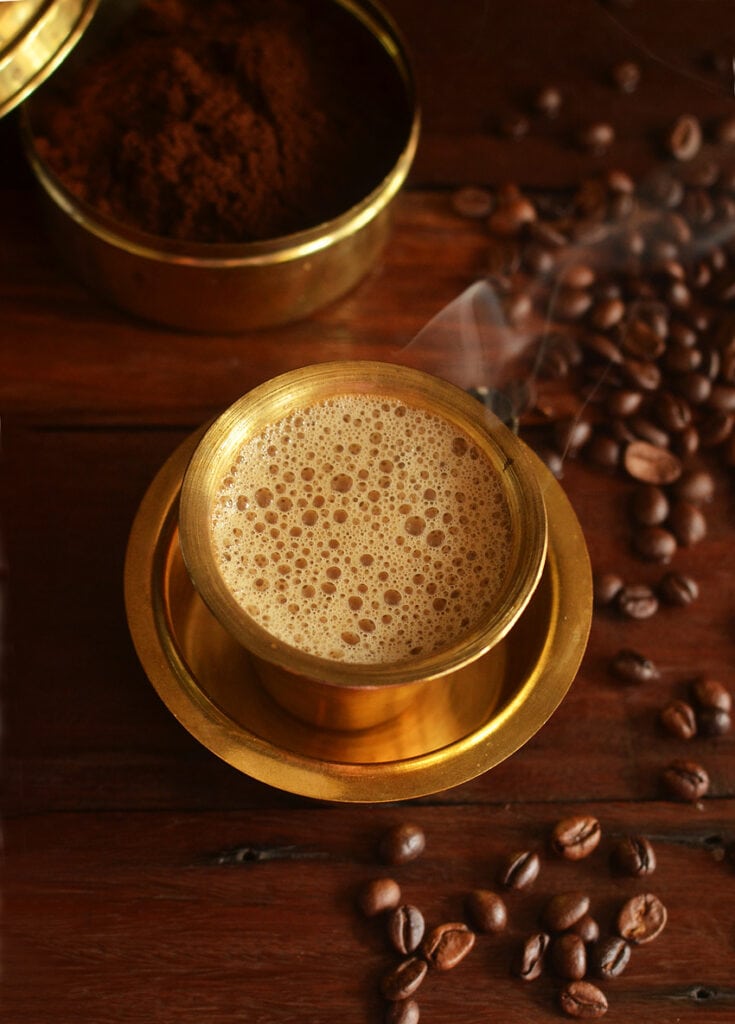
Kumbakonam Degree Coffee is made of a mix of Arabica and Robusta beans cultivated in southern India with Chicory mixed in. The coffee decoction is prepared by the drip-brew method with an authentic south Indian steel filter (2 stacked cylindrical drums with tiny slots of the one atop). The slow preparation of decoction makes the taste super strong. Fresh milk, milked from local cows is used.
The term ‘degree’ comes from the lactometer used to check the quality of the milk. It is normally served in a brass davarah (deep saucer/bowl) and tumbler. Frothing is created by pouring the coffee back & forth between davarah from a height. A visit to Tamil Nadu is just not complete without tasting Filter Kaapi or Kumbakonam Degree Kaapi. Contributed by Bhushavali of Travel Bhushavali.
Gahwa – Oman
One of the first things that I have noticed people in Oman serving guests is coffee. Arriving especially in Muscat, you will find people offering a strong cup of coffee after eating. Somewhat, coffee is the national pastime of the country. Coffee in Oman is a special beverage that is served as an excuse to sit together and talk.
I found that drinking coffee together in the country is a crucial part of local culture. For locals, it is an integral part of their customs, so much so that dallah, the traditional coffee pot, has become an unofficial mark of the Sultanate that represents the hospitality of Omanis.
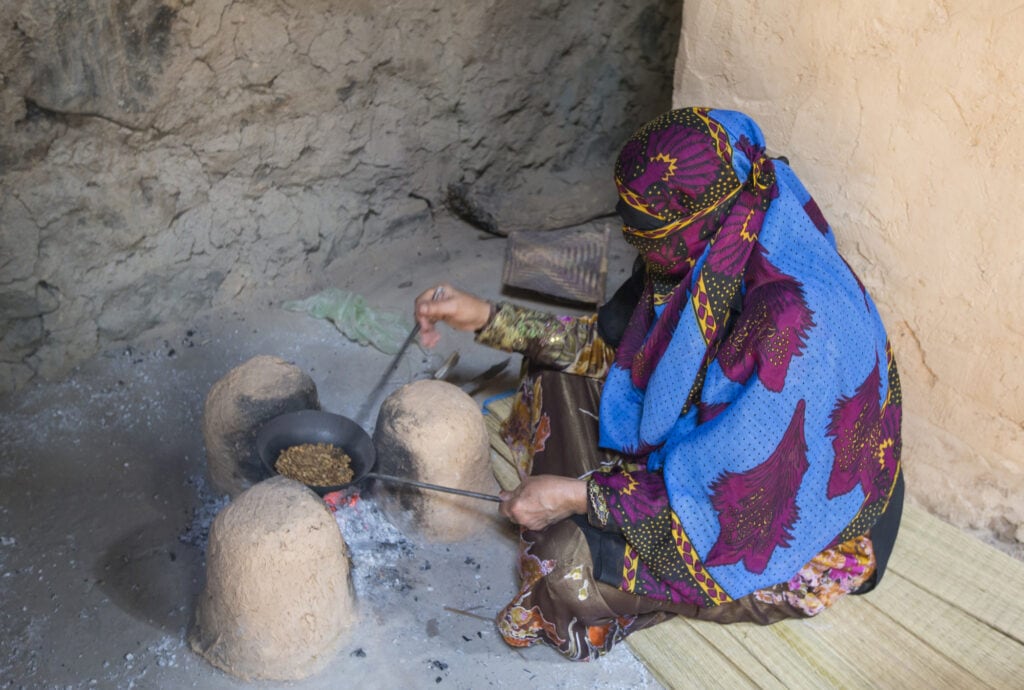
I also attended a coffee ceremony where people gather to discuss a series of questions and conclude the greeting by saying tafaddal, meaning ‘be at ease’. The gathering comes to a conclusion by offering guests coffee and dates, the classic ingredients of hospitality ritual.
They also consume fruits and other sweets as a part of this gathering. Experiencing the Omani coffee ritual along with shopping for hemp clothing brands was a great expedition for me. I experienced that life in Oman is the intersection of traditionalism and modernism. Contributed by Paulina of Paulina on the Road.
Luwak – Indonesia
Luwak coffee is a beverage derived from coffee beans that are harvested from the cleaned faeces of the wild civet. This warm drink has a more silken taste than coffee in general, possibly as a result of the fermentation process in the civet’s stomach. Indonesian Luwak coffee is considered to one be one of the most expensive coffees and luxury drinks in the world and is exported at exceptionally high prices.
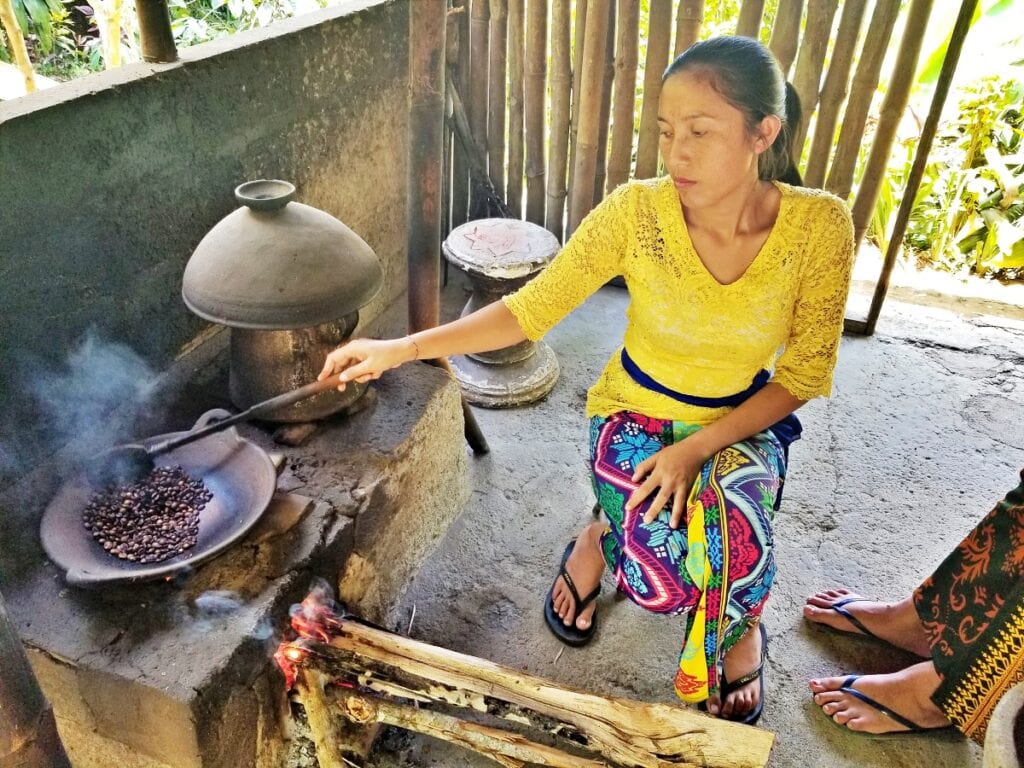
Due to its exotic value and rare availability, it’s not something you’ll find in any humble coffee shop across the island. There are only a handful of regions where it is served and produced such as Bali, Sumatra, and Sulawesi.
The taste of civet coffee is very delicate, there is an ever-so-slight hint of fruitiness which is refreshing and the aftertaste is very clean leaving no bitterness. This drink is best served hot, freshly ground, and brewed with no additions of milk or sweeteners.
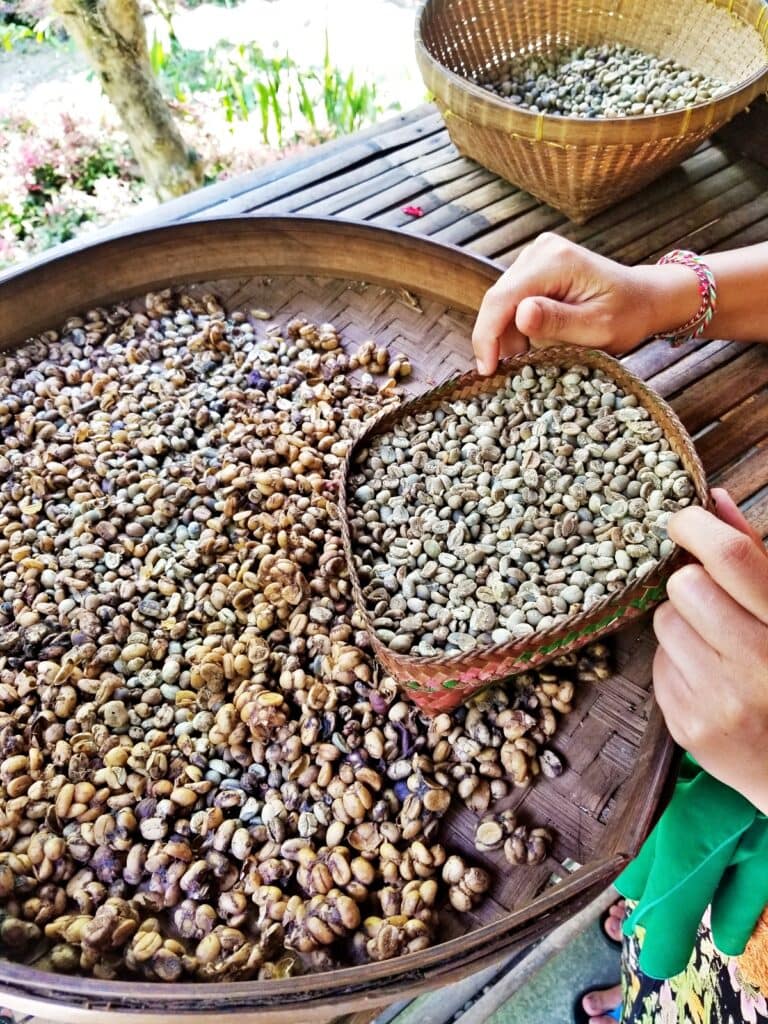
As a result of its collection process, not everyone can appreciate this drink because many are disgusted by the fact that it’s gathered from civet faeces. In light of this, the drink also has the nickname ‘cat poop coffee’. Despite the name, it’s most certainly worth trying at least once when visiting Indonesia. Contributed by Kaylini of The Curated Travelist.
Kafu – Bosnia
In the town of Mostar, I was served traditional Bosnian coffee. This coffee, although reminiscent of Turkish coffee, is different not just in its name, but in the way that it is prepared.
The coffee starts out with roasted beans that are ground to a fine powder and is then cooked in a džezva, a small copper pot with a long handle. When preparing Bosnian coffee, cold water is put into the džezva, which is then placed onto the stove to boil. Once the water comes to a boil, the džezva is removed and the coffee is added. The džezva is then placed back onto the stove until the liquid boils again, creating an intense flavour and thick foam.

Bosnian coffee is served on a copper tray with a ceramic cup filled with hot water, sugar cubes, and of course, a Rahat lokum (a jelly cube coated in sugar) on the side. Contributed by Olivia from Inspired by Croatia
Bunna – Ethiopia
You are guaranteed to have a good cup of coffee almost anywhere in the caffeinated drink’s birthplace, but especially so when you visit Harar in Ethiopia. Harar is known to grow some of the best beans in the country.
Ethiopian coffee, called bunna, is usually enjoyed in an elaborate coffee ceremony. To start the ceremony, the hostess will scatter aromatic leaves on the floor, followed by the burning of incense to ward off evil spirits.

A round-bottomed clay pot called a jebena is filled with water and placed on hot coals, infused with even more incense. While the water is heating up, the hostess will wash a handful of green coffee beans to clean them, and then start roasting them over the coals in a pan.
When the beans are dark and aromatic, the hostess will coarsely grind the beans with a mortar and pestle, and then add it to the water in the jebena. The mixture is then brought to a boil, and then it’s ready to be served.
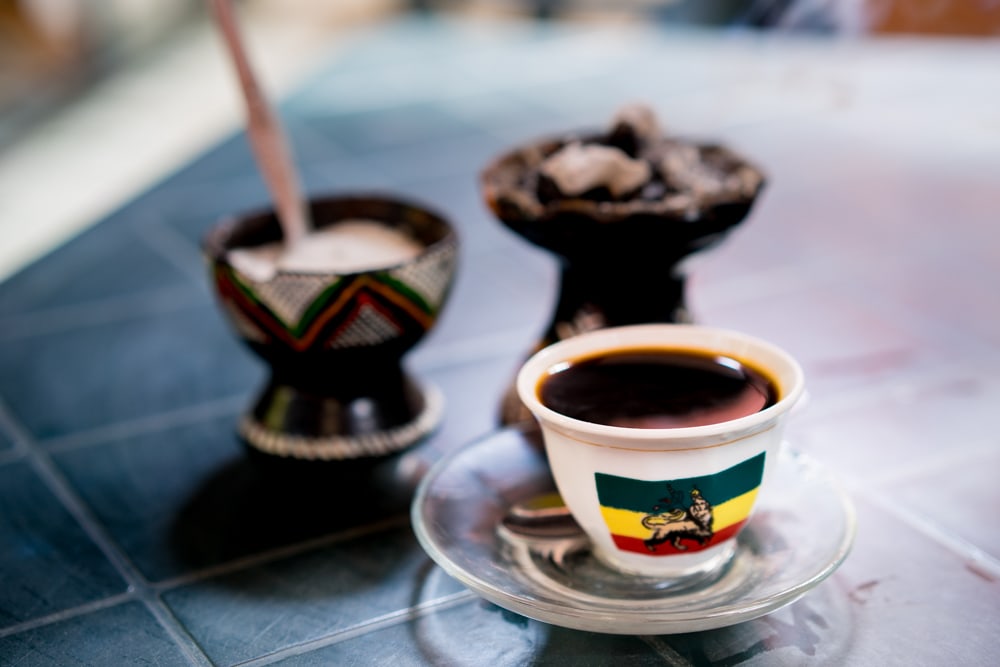
The bunna is served in small, porcelain cups without handles. Guests can add their own sugar, but it doesn’t come with milk. An Ethiopian coffee ceremony will include three servings, and each cup is believed to bless the person who drinks it. Contributed by De Wet & Jin from Museum of Wander.
Ca Phe Sua Da – Vietnam
Having lived as Digital Nomads in Vietnam, Antoine and Marielle of Offbeat Escapades developed a morning coffee ritual that involved visiting the cafe next door, ordering a Ca Phe Sua Da, and watching the bustling streets of cities like Saigon go by.

Ca Phe Sua Da is a traditional Vietnamese coffee made with dark-roasted and homegrown robusta beans. It is then sweetened with condensed milk to achieve its signature taste and drunk over crushed ice as a refreshing treat to Vietnam’s often humid weather. While the Ca Phe Sua Da in street stalls will come ready to drink, some serve it as the coffee brews through a small stainless steel filter, called the “phin,” which you have to mix yourself afterwards.
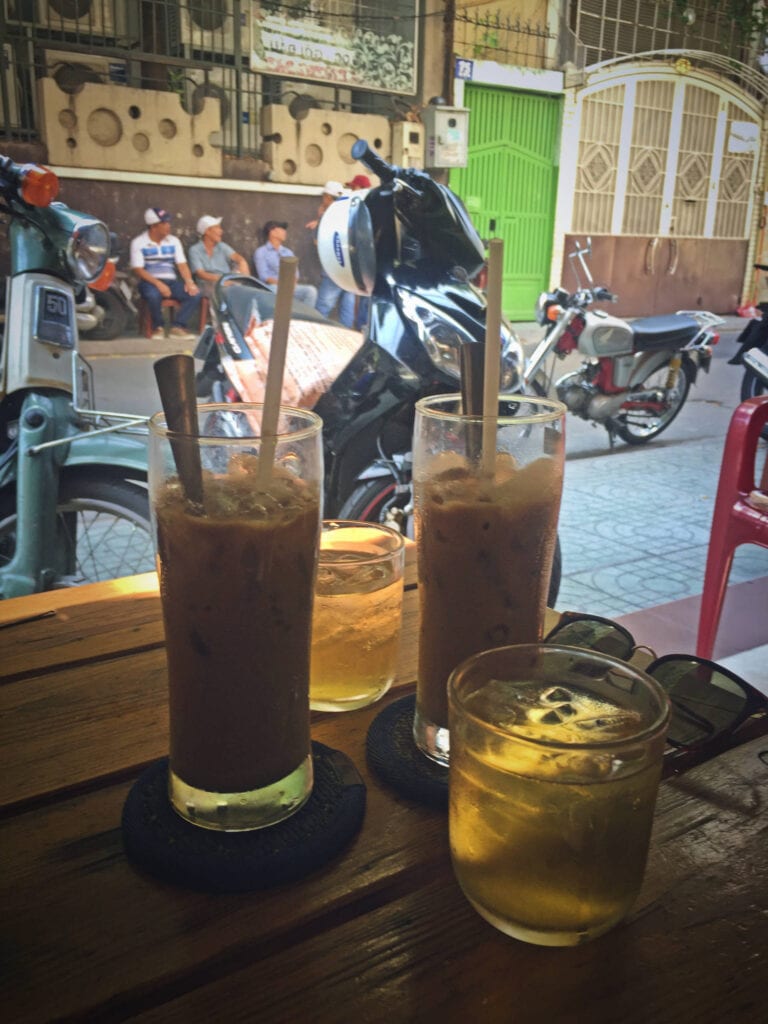
Ca Phe Sua Da finds its origins during the French colonial era, when dairy products were scarce and imported canned goods were seen as a way to replicate the original French milk coffee. Contributed by Antoine and Marielle of Offbeat Escapades.
Espresso – Rome
Espresso originated in Italy and like a real Italian, I loved drinking a couple of espressos a day, standing at a bar while exploring Rome. Espresso is a strong, concentrated coffee served in small servings and is used as the base for making most coffee-based drinks. A cappuccino is an example of an espresso-based drink, it is prepared with espresso, steamed milk, and steamed milk foam on top.

Espresso is prepared by forcing hot water under high pressure through very finely ground coffee beans using an espresso machine, resulting in a small, strong coffee shot topped with crema, a foam that forms on top, adding to the rich flavour. Espresso is now accepted internationally as a standard way of preparing coffee and is made by trained baristas in the best coffee shops all over the world. Contributed by Campbell and Alya of StingyNomads.
Kahvesi – Turkey
Coffee is an integral part of the culture in the Middle East, and Turkey is no exception. Coffeehouses were first opened in the capital over 500 years ago, and now you can find one in all the neighbourhoods in Istanbul. Turkish coffee uses finely ground coffee beans which are boiled with sugar and cardamom in a small coffee pot called a cezve.

The coffee is served in small cups and, as the coffee is unfiltered, it usually sits for a couple of minutes before it is served. This allows the grounds to sink to the bottom of the cup. There’s usually a thin layer of foam on the top of the coffee, and you usually drink it black without cream or milk. If you have a sweet tooth, you can add more sugar. Just remember not to drink the last sip, as the grounds aren’t pleasant to drink. And, in some regions, people believe that you can tell your fortune from the coffee grinds left in the cup. Contributed by Roxanne of FarAwayWorlds.
Egg Coffee – Vietnam
In Vietnam, coffee is a big deal. There are coffee shops on almost every street in each city. One of their most iconic and unique takes that you simply must try is the famous egg coffee. Dating back to the Vietnam war, this traditional brew incorporates egg yolk, sugar and condensed milk that is whisked into a foamy texture and served on top of a dark intense coffee. It is said that the drink was invented in Hanoi during the 1940s when fresh milk supplies were scarce. The beverage is often served in a small cup sat in a water bath with a candle underneath to maintain the temperature without the drink becoming too hot.

It must be said that this drink is not for those without a sweet tooth. The frothy egg mixture is very similar to that of an Italian meringue but has a richer, full-bodied punch, especially when offset with the bitterness of the strong black coffee underneath. Contributed by Matt and Lorna of TwoSoulsOnePath.com
Boon – Eritrea
The streets of downtown Asmara, Eritrea are filled with 1940s-style Italian cafes from during the country’s colonial period. But the real Eritrean coffee, called boon, actually goes back to several centuries before the Italians ever arrived.
Eritrean boon, like nearby Ethiopia’s buna, is traditionally enjoyed as a coffee “ceremony.” In this ceremony, a woman or girl starts with raw, green coffee beans. The raw beans are roasted in a small, metal pot with a long handle. While the beans are roasting, the woman passes the pot in front of the surrounding guests, who wave the aroma towards themselves for a whiff.

After roasting, the beans are ground and carefully poured into a jebena, a clay coffee pot. Ginger can also be added to the jebena to create a ginger boon. The woman then adds water and places the jebena over a stove to boil.
Once the boon is ready, a filter is added to the spout of the jebena. Then, the boon is poured into each finjal, a small coffee cup. Sugar is then added. Traditionally, boon is poured in three or more rounds and enjoyed with snacks such as popcorn or Eritrean bread. Contributed by Em of That Travelista.
Kaapi – South India
Filter Coffee is a quintessential part of morning ritual in South Indian households. Pronounced as Kaapi, it is served in the traditional “Davarah and Tumbler”, usually made of stainless steel or brass. Roasted coffee beans that are grown from the south Indian hill stations are the main ingredient. It is blended with a relatively less portion of chicory to make aromatic coffee powder, which is then added to an Indian coffee filter.

Pour in piping hot water and coffee powder, and allow them to soak and filter through. The result is the irresistibly aromatic decoction that is added to hot milk (sugar is usually added too) and frothed in the davarah and tumbler, which is an art in itself. South Indian Filter Coffee is rich and creamy in its taste and it certainly is something not to be missed if travelling in this part of India. Contributed by Anuradha from Country Hopping Couple.
Frappé – Greece
The number one drink that I loved to sip while relaxing on Athens’ beaches was a frappé coffee. It’s also known as a Greek frappé or a Nescafé frappé.
Even though the Greeks borrowed the name for this type of coffee from the French, the Greek coffee frappé is a Greek invention. The Greeks changed the French word and got a new Greek word: in Greek, a frappe is called ο φραπές. It is a cold drink made from black coffee with foam and whipped with ice. The classic Greek frappe is made exclusively from instant coffee, usually Nescafé. The Greek frappe’s key difference from other varieties of ice coffee: it must be whipped to get a big foam.
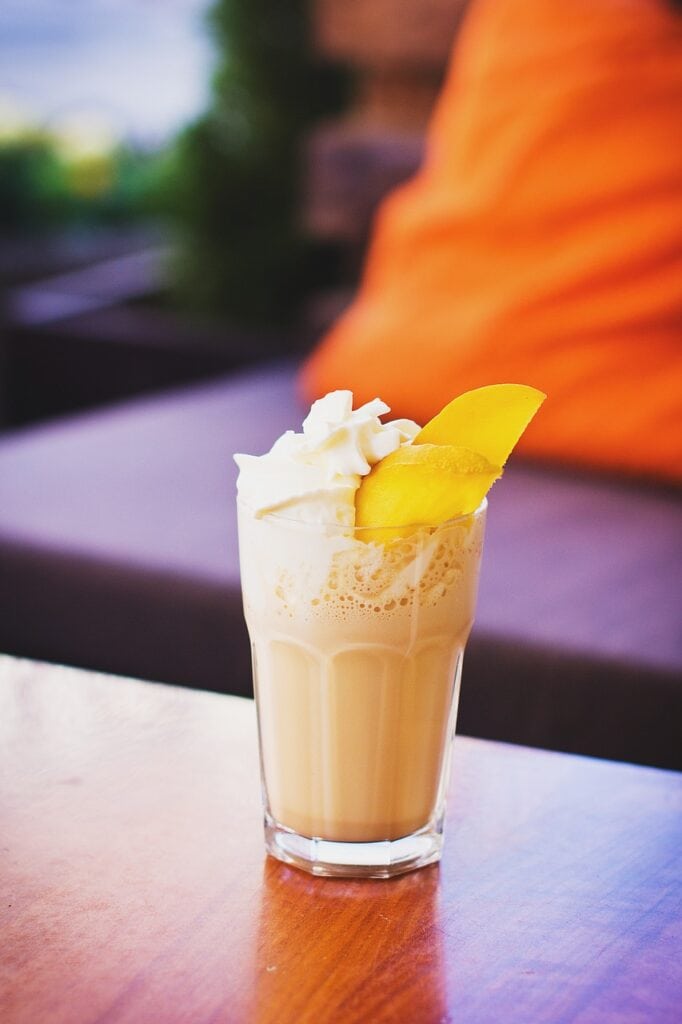
Greeks love to drink it not only in summer but all year round. There are many recipes for the frappé: Greeks often add sugar, milk, cream, ice cream, liqueurs, syrups, spices, and even Coca-Cola to the drink.
In a cafe, Greeks will usually serve you the frappé with a glass of water and cookies. Contributed by Sasha Naslin at The Alternative Travel Guide.
Cafe de la Olla – Mexico
Café de olla is a firm favourite in Mexico and it is traditionally brewed in a clay pot with raw sugar (piloncillo) and cinnamon.
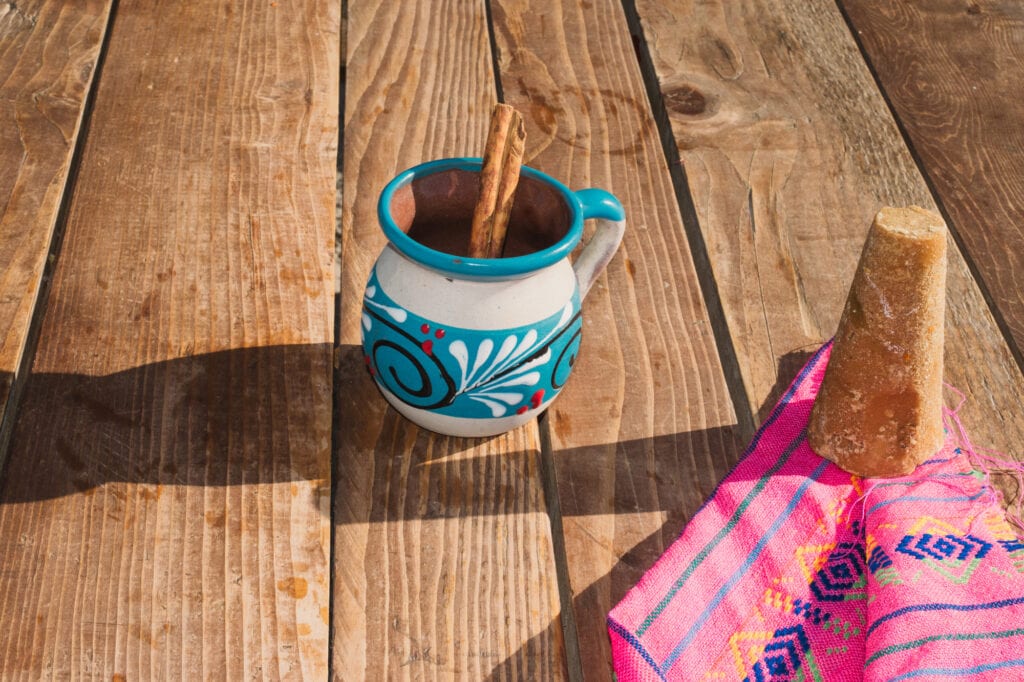
23 of the best Mexican Street Foods
Kahawa Chungu – Kenya
Kahawa chungu, or “bitter coffee”, is a traditional drink made in brass kettles over a charcoal stove and is typically enjoyed by men. To make the Kahawa Chungu you add cardamom pods and a cinnamon stick to the ground coffee on a charcoal stove in a brass pot if you like you can also add cloves and nutmeg.

Tims Double Double – Canada

In Canada, our coffee ritual is picking up a double-double from Tim Horton’s for our daily commute to work. Exactly what it sounds like a double-double is two cream and two sugar and Canadians are truly addicted to Timmies. I was told once by an employee at Tim’s that they put a tiny pinch of cinnamon and salt into the machine with the ground coffee – maybe that’s what makes it “addictive”?
Boon – Eritrea
Eritrea the small country in East Africa is one of the least visited countries in the world, due to its strict visa rules, but the ones that do manage to visit the country will get a chance to discover one of the most surprising coffee destinations in the world, and you get two different ways of coffee in the country.
Eritrea was an Italian colony for 60 years, and of the biggest influences the Italian heritage still has to this day in Eritrea, is its coffee culture, while even the smallest towns have an old Italian coffee bar with state-of-the-art Ekpersso machines from the 40 still being in use, making delicious coffee. However, if you want to go very local, so just visit any village, and you will get invited to a more traditional coffee ceremony called “Bun” which is similar to the ones in neighbouring Ethiopia.

The Bun is a coffee ceremony, where fresh coffee beans are roasted until dark before it´s grounded together with ginger and placed in a clay pot called a Jebena and warmed over a wooden fire before it´s served in small cups, often together with popcorn or sweets. Contributed by Christian of The Unusual Traveler.
Drip Coffee – USA
Coffee became popular in the US prior to the American Revolution when the Americans protested against Tea being taxed so heavily by the British.

So what is your favourite coffee ritual?
You might also like
UNESCO Intangible Cultural Heritage – food
French Food Culture: The Ultimate Guide
Pin it to save it




